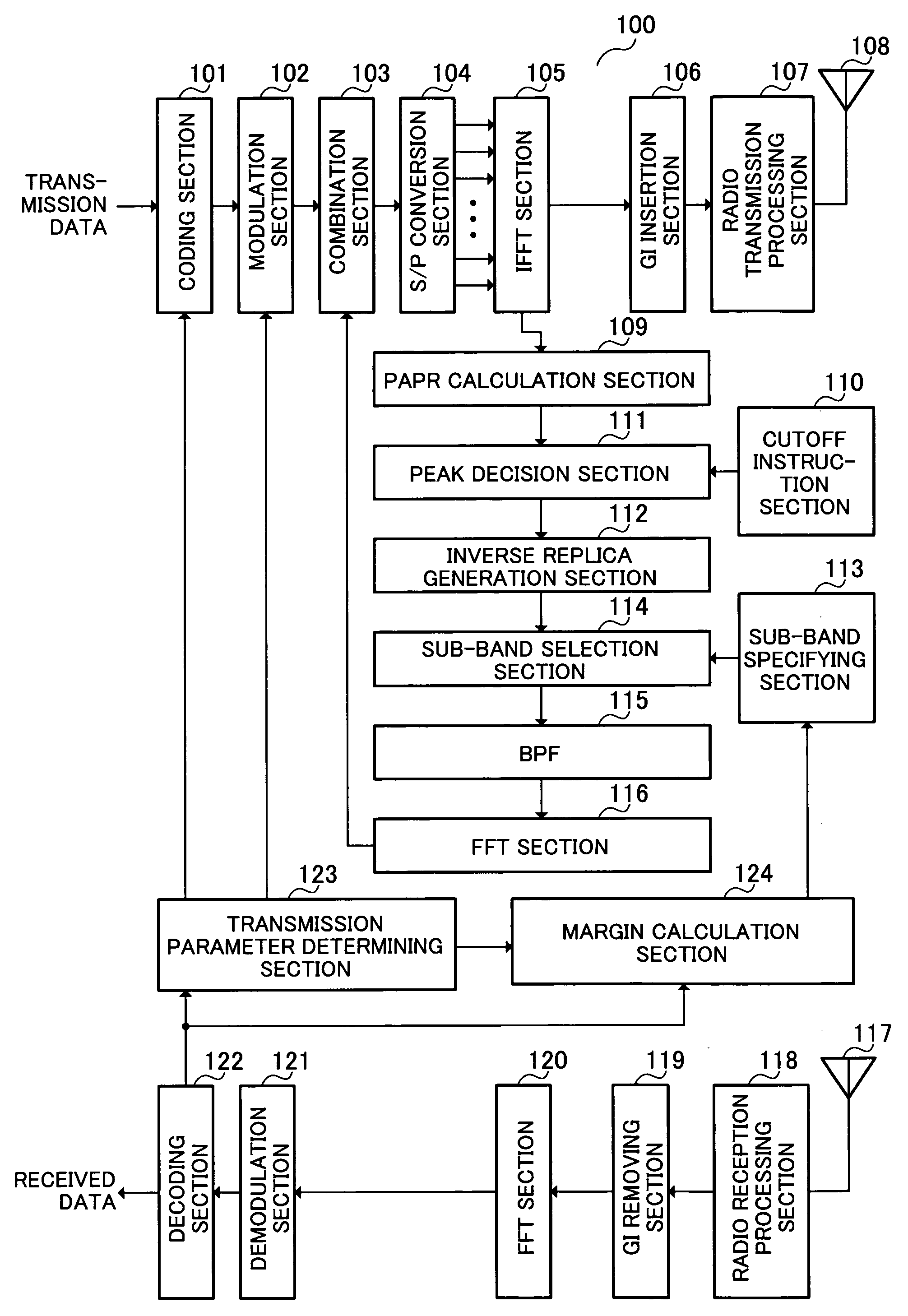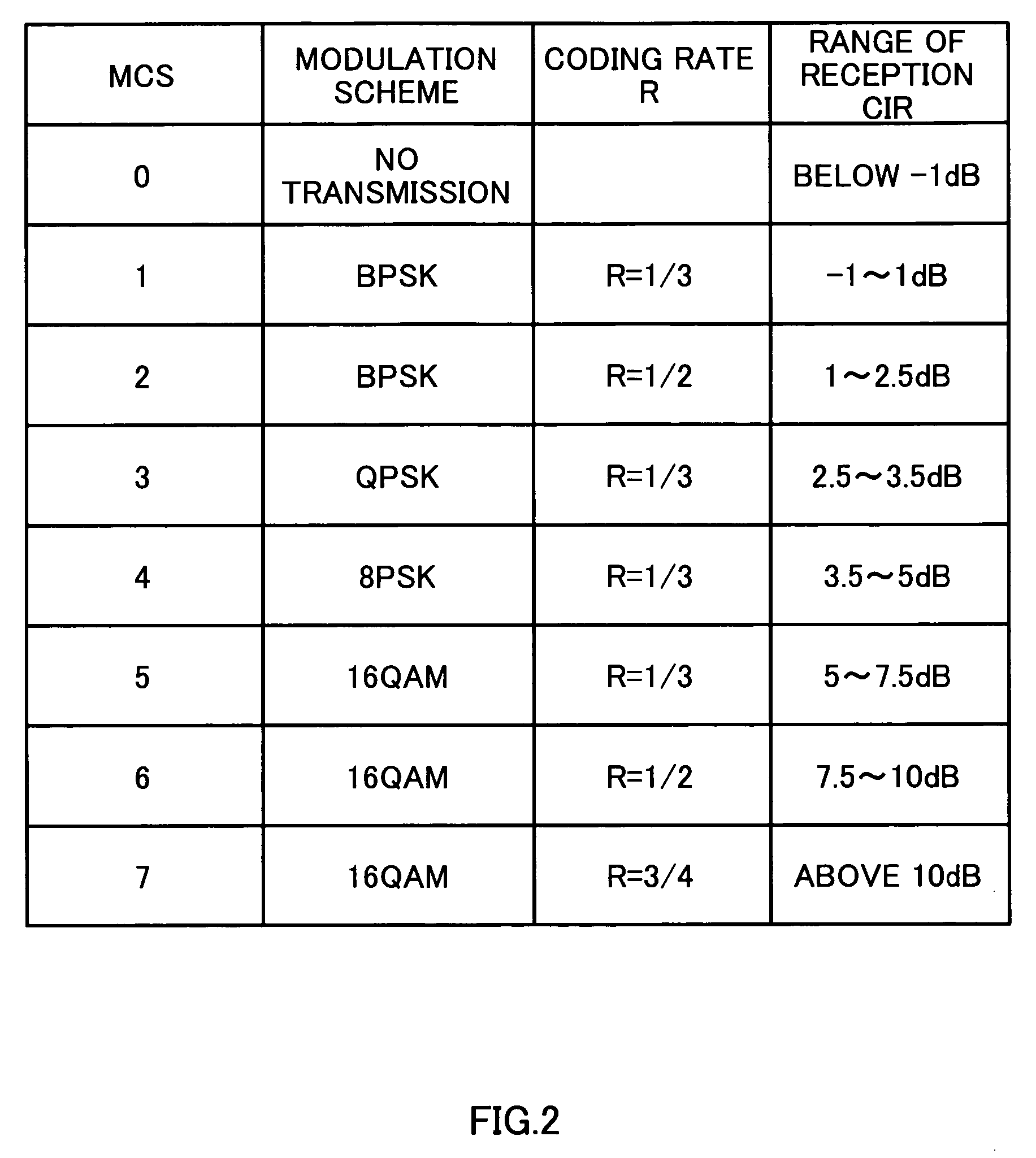Transmission apparatus and peak suppression method
a technology of transmission apparatus and peak suppression method, which is applied in the direction of electrical apparatus, digital transmission, secret communication, etc., can solve the problems of increasing the size of the amplifier, increasing power consumption, and expensive amplifiers, and achieve the effect of improving the overall throughput of the system
- Summary
- Abstract
- Description
- Claims
- Application Information
AI Technical Summary
Benefits of technology
Problems solved by technology
Method used
Image
Examples
embodiment 1
[0034]FIG. 1 is a block diagram showing the configuration of radio communication apparatus 100 according to Embodiment 1 of the present invention.
[0035] Coding section 101 codes transmission data at a coding rate from coding rate information input from transmission parameter determining section 123 and outputs the coded transmission data to modulation section 102.
[0036] Modulation section 102 modulates transmission data input from coding section 101 according to a modulation scheme based on modulation scheme information input from transmission parameter determining section 123 and outputs the modulated transmission data to combination section 103.
[0037] Based on inverse replica information, which is information about the waveform with an inverse characteristic of the waveform equal to or higher than a threshold input from FFT section 116 (hereinafter “inverse replica”), combination section 103 combines the waveform of the transmission data input from modulation section102 and the...
embodiment 2
[0071]FIG. 14 is a flowchart showing operation of a wireless communication apparatus when suppressing peaks. The radio communication apparatus according to this embodiment 2 has the same configuration as that in FIG. 1, and therefore explanations thereof will be omitted.
[0072] Peak suppression operation by the radio communication apparatus will be explained using FIG. 14 and FIG. 15.
[0073] First, IFFT section 105 performs IFFT on transmission data (step ST1401).
[0074] Next, PAPR calculation section 109 measures PAPR (step ST1402).
[0075] Next, as shown in FIG. 4, peak decision section 111 decides whether or not there is a peak whose PAPR is equal to or higher than threshold (a) from threshold information input from cutoff instruction section 110 (step ST1403).
[0076] When there is a peak whose PAPR is equal to or higher than threshold α, sub-band selection section 114 sets K=0 (step ST1404).
[0077] Next, sub-band selection section 114 selects N (N: natural number, equal to or sma...
embodiment 3
[0086]FIG. 18 and FIG. 19 are flow charts showing peak suppression operation by a radio communication apparatus. The radio communication apparatus according to this embodiment 3 has the configuration similar to that in FIG. 1, and therefore explanations thereof will be omitted.
[0087] Peak suppression operation by the radio communication apparatus will be explained using FIG. 18 and FIG. 19.
[0088] First, IFFT section 105 performs IFFT on transmission data (step ST1801).
[0089] Next, PAPR calculation section 109 measures PAPR (step ST1802).
[0090] Next, peak decision section 111 decides whether or not there is a peak whose PAPR is equal to or higher than threshold (a) from threshold information input from cutoff instruction section 110 as shown in FIG. 4 (step ST1803).
[0091] When PAPR is equal to or higher than threshold α, FFT section 116 performs FFT on an inverse replica (step ST1804).
[0092] Next, combination section 103 combines the transmission signal and the inverse replica ...
PUM
 Login to View More
Login to View More Abstract
Description
Claims
Application Information
 Login to View More
Login to View More - R&D
- Intellectual Property
- Life Sciences
- Materials
- Tech Scout
- Unparalleled Data Quality
- Higher Quality Content
- 60% Fewer Hallucinations
Browse by: Latest US Patents, China's latest patents, Technical Efficacy Thesaurus, Application Domain, Technology Topic, Popular Technical Reports.
© 2025 PatSnap. All rights reserved.Legal|Privacy policy|Modern Slavery Act Transparency Statement|Sitemap|About US| Contact US: help@patsnap.com



